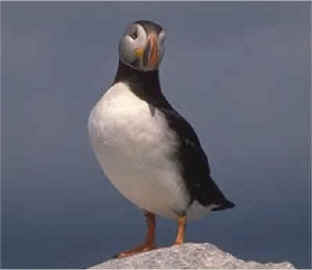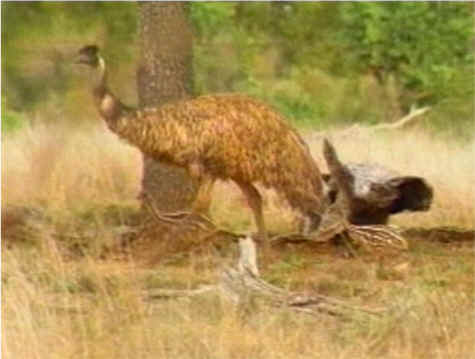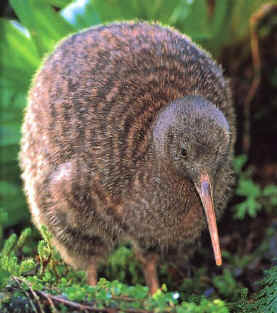All About Birds Pg 4
Flightless Birds

penguin swimming
Although it's true that all birds have feathers and wings, that doesn't necessarily mean they can all fly.
A penguin spends as much as 75% of it's life at sea. It doesn't use it's wings to fly -- it uses them to swim.
Its streamlined body and strong wings allow it to swim as fast as 15 miles per hour after fish, krill, squid and crustaceans.
Check out our KidZone Penguins section for more fun facts, photos and activities about penguins.

puffin
Puffins CAN fly, but they tend not to. Like the penguin, it uses its wings to move through the water catching fish and other small sea creatures by diving.
Puffins spend a few months each year living on an island. The rest of the time they live in the northern seas.
Puffins only go to the island when it is time to have babies. When the baby hatches and reaches about 6 weeks old, the parents return to the sea, stranding it on the island. All by itself, the chick learns to swim and catch fish to eat.

The largest living bird is the ostrich which can be as big as 8 feet tall and 330 pounds. The ostrich relies on its speed, size and strong kick rather than flight for safety. An ostrich can kill a person with one kick and can run up to 40 miles per hour.
Ostriches live in flocks in dry parts of Africa. Flocks can have as many as 600 birds in them.
Ostriches are vegetarian and spend much of their time searching out water.

Australian emu
The emus of Australia are the second largest bird. They can grow to 6 feet tall and weigh 100 pounds. Emus are also fast runners.
They live in smaller flocks on the dry plains and deserts in Australia. They feed on leaves, grass, and insects.
Father emus are the caregivers -- they build the nests, incubate the eggs and raise the babies until they are able to take care of themselves.

The New Zealand Kiwi has nothing to do with kiwifruit. It lives in moist forests and uses its long, bendable bill to poke around the ground in search of worms.
Unlike many of the other flightless birds, the kiwi is not very large. It's only about a foot and a half long. To avoid predators, the kiwi hides during the day and comes out at night to search for food.
The kiwi has fine feathers that make it look almost furry. It has no tail feathers and its wings are so small they're typically not very easy to see.
The Rhea of South America, the Kakapo of New Zealand and the Cassowary of Australia and New Guinea are also flightless birds. A number of extinct birds were also flightless, including the Dodo of Mauritius and the Moa and Dinornis of New Zealand.
Scientific information:
- Penguins make up the scientific "order" Sphenisciformes.
- Puffins belong to the scientific order Alcidae.
- Ostriches make up the scientific order Struthioniformes.
- Cassowaries and Emus make up the scientific order Casuariiformes.
- Kiwis make up the scientific order Apterygidae.
- Rheas makes up the scientific order Rheiformes.